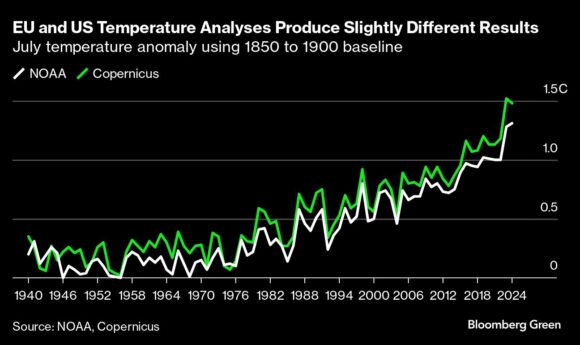July saw record-breaking heat around the world, including the hottest day ever recorded and multiple national heat records. But whether it was the hottest month in history depends on who you ask.
Last week, Copernicus — the EU’s climate science service — said July was the second hottest month ever recorded. But this week, NASA and the US National Oceanic and Atmospheric Administration (NOAA) said it was the world’s hottest. The disparity masks a remarkable level of agreement on these points — the difference between these gold-standard datasets is just a few hundredths of a degree. But it also casts light on the difficulty of creating a complete global climate record, and some of the things we don’t yet know about how exactly the planet is warming.
One thing is for sure: This past July was hot. Since July is usually the hottest month of the year, that at the very least means the world just experienced one of the hottest months ever recorded. And it’s the latest in a long line of record-breaking months.
World Records Hottest Day While Wildfires Threaten Mediterranean
The challenge for global temperature analyzers, says Kate Marvel, research physical scientist at the NASA Goddard Institute for Space Studies (GISS), is that there’s no way to take one temperature reading for the whole planet. “We don’t have a single global thermometer that we can use to take the temperature of the whole globe. Instead, we have a bunch of different tools that we can use to measure various parts of the planet and various aspects of the climate system.”
NASA and NOAA use a slightly different approach than Copernicus. The EU’s flagship climate program relies on a method called reanalysis, based on its ERA5 climate model. It uses that model to create a forecast, which is then reconciled with data gathered from surface level weather stations, satellites and airplanes. This process means Copernicus can produce a near real-time picture of the Earth’s climate, including temperature, wind and precipitation for around every 30-square-kilometer chunk of the planet’s surface.
At NOAA, scientists use observations from land and sea weather stations to calculate the average surface temperature. Researchers conduct a statistical analysis to fill in data gaps that takes into account historic data and nearby observations.
After all these millions of data points have been ingested and analyzed, the difference stems from the tiniest of margins: NOAA found July was 0.03C (0.05F) hotter than July last year, NASA’s analysis shows it was 0.02C warmer, while Copernicus says this July was just 0.04C cooler than July 2023.

Each of these monthly analyses are accurate only to around 0.08C, and rankings can turn on a difference as tiny as 0.02C, says Gavin Schmidt, director of NASA GISS. The average difference between Copernicus’s analysis and NASA’s in recent years is about 0.06C, he says.
One possible reason for the discrepancy, says Peter Jacobs, a climate scientist at the NASA Goddard Space Flight Center, is that the reanalysis data takes air temperatures from above the ocean, while the NOAA and NASA observational data takes water temperature readings. Water warms and cools more slowly than air, potentially creating a lag.
Another possible reason is what both analyses do with the areas where they don’t have good data, such as the Arctic. The reanalysis Copernicus does can use satellite readings, which rely on infrared and microwave data, rather than solely temperature readings, while NASA and NOAA rely on a statistical analysis of the likely temperatures to fill in the gaps.
Geographically, though, there is significant agreement between the approaches, notes Berkeley Earth research scientist Zeke Hausfather. For example, the dataset show the tropical Pacific Ocean is much cooler in July 2024 than it was in 2023, as El Nino fades. All global temperature datasets are also unequivocal that the planet is rapidly warming.
The real concern isn’t the few hundredths of a degree difference between the datasets but rather that temperatures have remained this hot, Hausfather says: “The fact that we’re matching those so far this year is a little worrying.” Last year’s string of record heat “set the bar so high. It’s crazy that we’re even tying that.”
Photograph: Firefighters and volunteers work to extinguish a wildfire in Krieza, on Evia Island, Greece, on Tuesday, July 30, 2024. Photo credit: Nick Paleologos/Bloomberg
Topics Trends
Was this article valuable?
Here are more articles you may enjoy.



 Wildfire Losses Drop Chubb Q1 Net Income 38%, While Tariffs Create ‘Confusion’
Wildfire Losses Drop Chubb Q1 Net Income 38%, While Tariffs Create ‘Confusion’  Global Q1 Commercial Insurance Rates Drop 3%, but US Casualty Bucks the Trend
Global Q1 Commercial Insurance Rates Drop 3%, but US Casualty Bucks the Trend  Florida Class Action Targets Litigation Funding Firm Over Data Breach
Florida Class Action Targets Litigation Funding Firm Over Data Breach  Group Sues California Department of Insurance Over FAIR Plan Surcharges
Group Sues California Department of Insurance Over FAIR Plan Surcharges 

